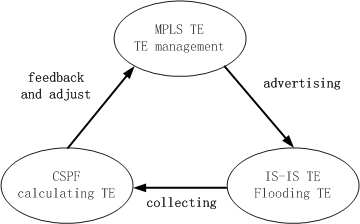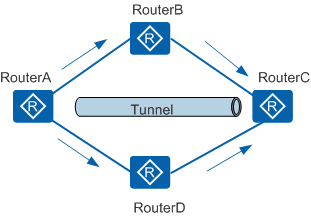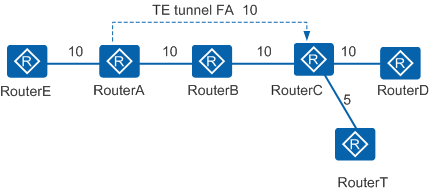IS-IS TE
Conventional routers select the shortest path as the primary route regardless of other factors, such as bandwidth. In this manner, traffic is not switched to other paths even if a path is congested. MPLS traffic engineering (TE) has advantages in solving the problem of network congestion. With MPLS TE, you can precisely control the traffic path and prevent traffic from passing through congested nodes. MPLS TE can reserve resources to ensure the quality of services during the establishment of LSPs.
c
New TLVs in IS-IS TE
To carry TE information in LSPs, IS-IS TE defines the following TLVs in RFC 5305:
Extended IS reachability TLV
This TLV takes the place of IS reachability TLV and extends the TLV formats with sub-TLVs. Sub-TLVs are implemented in TLVs in the same manner as TLVs are implemented in LSPs. Sub-TLVs are used to carry TE information configured on physical interfaces.

Currently, all sub-TLVs defined in RFC 5305 are supported.
Table 1 Sub-TLVs defined in Extended IS reachability TLV Name
Type
Length (Byte)
Value
Administrative Group
3
4
Indicates the administrative group.
IPv4 Interface Address
6
4
Indicates the IPv4 address of a local interface.
IPv4 Neighbour Address
8
4
Indicates the IPv4 address of a neighbor interface.
Maximum Link Bandwidth
9
4
Indicates the maximum bandwidth of a link.
Maximum Reserved Link Bandwidth
10
4
Indicates the maximum reserved bandwidth of a link.
Unreserved Bandwidth
11
32
Indicates the unreserved bandwidth.
Traffic Engineering Default Metric
18
3
Indicates the default metric of TE.
Bandwidth Constraints sub-TLV
22
36
Indicates the TLV of the bandwidth constraint.
Traffic Engineering router ID TLV
It is of TLV type 134, with a 4-byte Router ID. It is used as the MPLS LSR ID. In MPLS TE, a Router ID uniquely identifies a router. Each router has a Router ID.
Extended IP reachability TLV
This TLV takes the place of IP reachability TLV and carries routing information. It extends the length of the route cost field and carries sub-TLVs.
Shared Risk Link Group TLV
It is of TLV type 138 and used to carry information about the shared risk link group. This TLV can carry information about multiple shared links, each of which is a 4-byte positive integer.
IS-IS TE Implementation
IS-IS TE is implemented in two stages:
Respond to MPLS TE configurations.
IS-IS TE functions only after MPLS TE is enabled.
IS-IS TE updates the TE information in IS-IS LSPs based on MPLS TE configurations.
IS-IS TE transmits MPLS TE configurations to the CSPF module.
Handle TE information in LSPs.
IS-IS TE extracts TE information from IS-IS LSPs and transmits the TE information to the CSPF module.
In typical applications, IS-IS TE helps MPLS TE set up TE tunnels. As shown in Figure 2, a TE tunnel is set up between RouterA and RouterD.
The networking configuration is as follows:
Enable MPLS TE on RouterA, RouterB, RouterC, and RouterD and enable MPLS TE CSPF on RouterA to calculate the tunnel path.
Run IS-IS and enable IS-IS TE on RouterA, RouterB, RouterC, and RouterD to implement communication between the four routers.
After the preceding configuration is complete, IS-IS on RouterA, RouterB, RouterC, and RouterD sends LSPs carrying TE information configured on each router. RouterA then obtains the TE information of RouterB, RouterC, and RouterD from the received LSPs. The CSPF module can calculate the path required by the TE tunnel based on the TE information on the entire network.
Route Calculation on TE Tunnel Interfaces
IS-IS Shortcut (AA) and IS-IS Advertise (FA) calculate routes through TE tunnel interfaces. For traffic transmitted through a specific route, MPLS guarantees reliable forwarding whereas IP is less reliable. MPLS forwarding is achieved when IS-IS Shortcut (AA) and IS-IS Advertise (FA) are configured, with TE tunnel interfaces involved in route calculation and defined as the outbound interfaces of specific routes.
IS-IS Shortcut (AA) and IS-IS Advertise (FA) have the following differences:
IS-IS Advertise (FA) advertises TE tunnel information to other ISs, whereas IS-IS Shortcut (AA) does not.
As shown in Figure 3, if the TE tunnel is enabled with IS-IS Advertise (FA), RouterA advertises information indicating that RouterC is its neighbor. The neighbor information is carried in TLV type 22 with no sub-TLVs. That is, no TE information is carried. If the TE tunnel is enabled with IS-IS Shortcut (AA), RouterA does not advertise such information.
IS-IS Advertise (FA) affects the SPF tree of other routers, whereas IS-IS Shortcut (AA) does not.
IS-IS Shortcut (AA) does not affect the original structure of the IS-IS SPF tree, irrespective of whether a TE tunnel exists or not. Apart from the link from RouterA to RouterB, and that from RouterB to RouterC, a link marked with Shortcut from RouterA to RouterC is added. The link marked with Shortcut participates in route calculation.
If the TE tunnel is enabled with IS-IS Advertise (FA), RouterA advertises the message that "RouterC is a neighbor of RouterA" to other routers on the network. Other routers then consider RouterC a neighbor of RouterA and add RouterC to the SPF tree without marking it with Shortcut.
IS-IS Advertise (FA) does not support a relative metric, whereas IS-IS Shortcut (AA) does.
IS-IS Shortcut (AA) supports an absolute metric and a relative metric.
If you use an absolute metric, the metric value of TE tunnels in IS-IS is fixed. If you use a relative metric, the metric value of TE tunnels in IS-IS is the sum of the physical link cost and relative metric. As shown in Figure 3, if the relative metric is set to 1, the cost of the path from RouterA to RouterC through the TE tunnel is 21 (10+10+1). If the relative metric is set to 0, the TE tunnel and physical link are of equal-cost on the outbound interface. If the relative metric is less than 0, the TE tunnel interface is preferred as the outbound interface.
IS-IS Advertise (FA) requires bidirectional TE tunnels, whereas IS-IS Shortcut (AA) requires only unidirectional tunnels.


